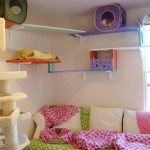How to Decorate a Child Care Room: Creating a Stimulating and Safe Environment
Decorating a child care room involves more than just aesthetic choices; it requires a thoughtful approach to creating a space that is conducive to learning, development, and safety for young children. A well-decorated room can stimulate imagination, encourage exploration, and provide a sense of comfort and belonging. The following outlines key considerations and practical tips for effectively decorating a child care room.
Understanding Child Development Stages
Before initiating any decorating project, it is crucial to understand the developmental stages of the children who will be using the room. Infants, toddlers, and preschoolers have different needs and interests, so the décor should be tailored to their specific capabilities and learning objectives. For instance, an infant room should prioritize soothing colors, soft textures, and visually stimulating mobiles, while a preschool room can incorporate more interactive elements such as activity centers and themed learning areas.
Color psychology plays a significant role in child development. Calming colors, such as blues and greens, can promote relaxation and focus, while brighter colors like yellow and orange can stimulate creativity and energy. However, it is important to use bright colors sparingly, as overstimulation can lead to restlessness and behavioral issues. A balanced color palette that incorporates both calming and stimulating colors is often the most effective approach. Consider incorporating natural elements such as wood and plants, which can create a sense of tranquility and connection to the outdoors.
Furthermore, the layout of the room should be designed to facilitate different types of play and learning. Designate specific areas for quiet activities, such as reading and puzzles, and areas for more active play, such as block building and dramatic play. Clear pathways and open spaces will encourage children to move freely and explore their environment. Remember that safety is paramount, and all furniture and equipment should be age-appropriate and securely anchored to prevent accidents.
Prioritizing Safety and Health
Safety and health are non-negotiable aspects of child care room décor. All materials used should be non-toxic, durable, and easy to clean. Avoid using products that contain lead, phthalates, or other harmful chemicals. Regularly inspect the room for potential hazards, such as sharp edges, exposed wires, and loose rugs. Conduct routine maintenance to ensure that all equipment is in good working order and meets safety standards.
Flooring should be soft and resilient to cushion falls and reduce noise levels. Options such as interlocking foam tiles or padded vinyl flooring are ideal for child care settings. Walls should be painted with washable, low-VOC paint to ensure easy cleaning and minimize exposure to harmful chemicals. Furthermore, consider incorporating acoustic panels or other sound-absorbing materials to reduce noise levels and create a more peaceful environment.
Hygiene is another critical consideration. Implement a regular cleaning schedule and provide easily accessible handwashing stations with soap and paper towels. Ensure that all surfaces are disinfected regularly, especially those that children come into contact with frequently, such as tables, chairs, and toys. Proper ventilation is also essential to maintain air quality and prevent the spread of germs. Consider installing an air purifier to remove allergens and pollutants from the air.
Creating a Stimulating Learning Environment
A well-decorated child care room should be a stimulating and engaging learning environment that encourages children to explore, discover, and learn. Incorporate a variety of learning centers that cater to different interests and developmental levels. Examples include a reading corner with comfortable seating and a diverse selection of books, a science center with hands-on experiments and natural materials, and an art center with a wide range of art supplies.
Display children's artwork prominently to create a sense of ownership and pride. Use display boards, clotheslines, or picture frames to showcase their creations. Rotate the artwork regularly to keep the display fresh and engaging. Involve children in the decorating process by allowing them to contribute their ideas and help create decorations. This will foster a sense of belonging and encourage them to take ownership of their learning environment.
Incorporate natural light whenever possible, as it has numerous benefits for children's well-being and cognitive development. Position learning centers near windows to maximize natural light exposure. If natural light is limited, use full-spectrum lighting to mimic the effects of sunlight. Furthermore, consider incorporating elements of nature into the décor, such as plants, rocks, and shells. These natural elements can help create a calming and stimulating environment that fosters curiosity and exploration.
Integrating technology thoughtfully can also enhance the learning experience. Interactive whiteboards, tablets, and educational apps can be used to engage children in interactive learning activities. However, it is important to use technology in moderation and balance it with other types of learning activities, such as hands-on exploration and social interaction.
Organizing Space Efficiently
Efficient organization is crucial for maintaining a clean, safe, and functional child care room. Implement a clear and logical storage system that allows children and staff to easily access and put away materials. Use labeled bins, shelves, and drawers to organize toys, books, and art supplies. Color-coding can also be an effective way to organize materials and help children develop visual recognition skills.
Maximize vertical space by using wall-mounted shelves and cabinets. This will free up floor space and create a more open and spacious environment. Consider using clear storage containers so that children can easily see what is inside. This will encourage them to take responsibility for putting away their belongings and help them develop organizational skills.
Create designated areas for different activities and ensure that each area is well-equipped with the necessary materials. This will help children stay focused and engaged in their activities. Regularly declutter the room and remove any items that are no longer needed or used. This will help maintain a clean and organized environment that is conducive to learning and play.
Optimize furniture arrangement to promote ease of movement and interaction. Ensure that there are clear pathways between learning centers and that furniture is arranged to encourage social interaction. Consider using flexible furniture that can be easily rearranged to accommodate different activities and group sizes. This will allow you to adapt the room to meet the changing needs of the children and staff.
Incorporating Sensory Elements
Engaging children's senses is an essential aspect of creating a stimulating and enriching child care environment. Incorporate a variety of sensory elements into the décor to provide children with opportunities for exploration and discovery. Sensory bins filled with materials such as sand, water, rice, or beans can provide hours of tactile exploration. Add tools such as scoops, cups, and funnels to encourage children to experiment and manipulate the materials.
Create a textured wall using a variety of materials such as fabric, carpet squares, or corrugated cardboard. This will provide children with opportunities to explore different textures and develop their tactile senses. Incorporate natural elements such as plants, rocks, and shells to engage children's senses of sight, smell, and touch. Consider creating a sensory garden where children can explore different plants and flowers with their senses.
Use music and sound to create a calming and stimulating atmosphere. Play soft, instrumental music during quiet times to promote relaxation and focus. Use sound effects, such as nature sounds or animal sounds, to enhance learning activities and engage children's auditory senses. Incorporate musical instruments, such as shakers, drums, and xylophones, to encourage children to explore different sounds and rhythms.
Aromatherapy can also be used to create a soothing and inviting environment. Use essential oil diffusers to disperse calming scents, such as lavender or chamomile, during quiet times. Avoid using strong or overpowering scents, as they can be irritating or overwhelming for some children. Ensure that all essential oils are used safely and appropriately, and that they are kept out of reach of children.

How To Decorate A Daycare Center Procare Solutions
Daycare Ideas Interior Design Inspiration For Your Childcare Center

Daycare Ideas Interior Design Inspiration For Your Childcare Center Decor Setup

1 Ultimate Guide For The Best Childcare Design

Daycare Ideas An Ideabook By Kellbell100

How To Decorate A Daycare Center Procare Solutions

What Makes A Good Daycare Space Design By Rainforest Learning Centre

Pin On Prek

Daycare Ideas Interior Design Inspiration For Your Childcare Center

Personalise Childcare Classroom Design Ryangi







